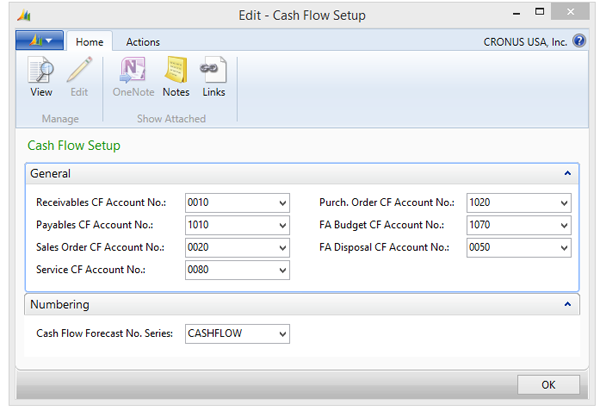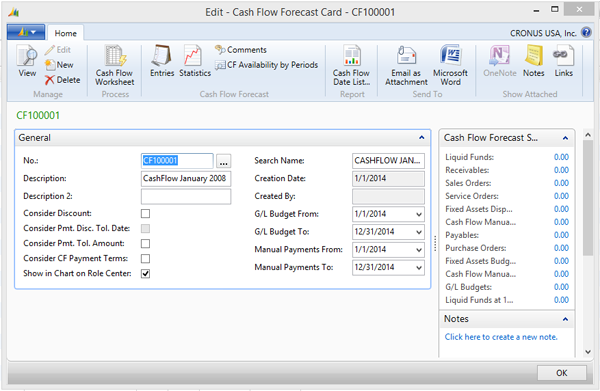Microsoft Dynamics NAV 2013 R2 New Feature - Cash Flow Functionality

Understanding and estimating your cash flow is critical in running a successful business. With Microsoft Dynamics NAV 2013 R2, a new feature called Cash Flow was introduced. This feature allows users to understand the inflows and outflows of cash in their business. It helps in creating short-term forecasts that provide knowledge to the user to predict how and when you can expect funds to be paid and collected by your business.
The data collected is based upon transactions that already exist in Dynamics NAV, which thereby reduces the need to perform external estimating of your cash position. The Dynamics NAV Cash Flow functionality allows you to use familiar features, such as Account Schedules and Analysis by Dimension, to analyze and report your Information.
Setting up this feature is easy and can help you analyze the cash position of your organization and better understand your business. To set up this feature and start collecting data to analyze your cash flow, there are 6 critical steps needed.
6 Steps Required to Use Dynamics NAV 2013 R2 Cash Flow Functionality
Step 1 – Chart of Cash Flow Accounts
Step 2 – Perform Setup for Cash Flow Functionality
Step 3 – Create Cash Flow Forecast
Step 4 – Create Manual Entries
Step 5 – Create Cash Flow Worksheet
Step 6 – Register Cash Flow Worksheet
Figure 1 – The Six Steps for Cash Flow
Step One: Set Up Your Chart of Cash Flow Accounts
The most basic part of cash flow is the chart of cash flow accounts, in which all cash flow forecast entries are registered. You use the window to enter and view your cash flow accounts. Create the chart of cash flow accounts as you create new cash flow accounts. You can set up new cash flow accounts in the window or in the Cash Flow Account Card.

Figure 2 – Cash Flow Account Card
Step Two: Perform the Setup for Cash Flow Functionality
The cash flow setup page specifies the cash flow accounts that are used for the entries in the areas of general ledger, purchases, sales, services, and fixed assets. You also define the number series for your cash flow forecasts.

Figure 3 – Cash Flow Setup
When the Suggest Worksheet Lines batch job calculates the forecasted cash inflows and outflows of your company, you must make sure that the relevant information in the cash flow forecast appears in the appropriate cash flow accounts.
Step Three: Create Cash Flow Forecast
The Cash Flow Forecast card is used to set the parameters used to calculate the cash inflows and outflows of your business and to save the values as history. For example, you can set up the cash flow forecast for every week or every month. You can set up multiple cash flow forecasts as needed for your business.

Figure 4 – Cash Flow Forecast Card
Every cash flow forecast has its own Cash Flow Forecast card. For each cash flow forecast, you must set up a card on which you enter basic information, such as the cash flow forecast number, discount possibilities, payment terms, manual expenses, and manual revenues.
Below is an excerpt from Microsoft Dynamics NAV Help Screens on the Cash flow forecasts fields are used:
| Field | Description |
|---|---|
| No. | Specifies the number for your cash flow forecast. You can use one of the following methods:
|
| Consider Discount | Select to have the cash discounts assigned in entries and documents reflected in the cash flow forecast. |
| Consider Pmt. Disc. Tol. Date | Select if you want to use the payment discount tolerance date when the cash flow date is being calculated. You can only select this option if you choose to take the discount into consideration. |
| Consider Pmt. Tol. Amount | Select to use the payment tolerance amounts from the posted customer ledger entries and the vendor ledger entries in addition to the payment tolerance amounts from the general ledger for sales and purchase orders in the cash flow forecast. |
| Consider CF Payment Terms | Select if you want to use the cash flow payment terms that are defined for customers or vendors.
Note: If the check box is selected, but cash flow payment terms are not defined for customers or vendors, the standard payment terms are used. |
| G/L Budget From | Enter the start date from which you want to use the budget values from the general ledger in the cash flow forecast. |
| G/L Budget To | Enter the last date from which you want to use the budget values from the general ledger in the cash flow forecast. |
| Manual Payments From | Enter a start date from which manual payments should be included in the cash flow forecast. |
| Manual Payments To | Enter the last date from which manual payments should be included in the cash flow forecast. |
| Show in Chart on Role Center | Select to display the cash flow chart on the Role Center. |
Step Four: Create Manual Entries
Cash Flow manual entries allow you to book cash flow estimates that will affect your cash flow forecast. For example, you can use this table to register manual expenses such as salaries, interest on credit, or planned investments. You can create entries to record Anticipated Revenue and Anticipated Expenses in the Cash Flow Manual Revenues and Cash Flow Manual Expenses windows in Dynamics NAV.

Figure 5 – Cash Flow Manual Revenues and Expenses
Step Five: Create Worksheet
The cash flow worksheet specifies the relevant information for the cash flow forecast.

Figure 6 – Cash Flow Worksheet
You do not have to make the cash flow forecast manually. You can use the Suggest Worksheet Lines batch job to get the relevant information from the following application areas:
- Liquid funds
- Open receivables
- Sales orders
- Service orders
- Planned disposal of fixed assets
- Open payables
- Purchase orders
- Budgeted purchase of fixed assets
In addition to the items in the previous list, you can set up manual revenues and manual expenses that will be included in the forecast.
Each time you begin the batch job, you can decide which information should be part of the cash flow forecast. The batch job suggests preliminary information for the forecast. You can update the information if it is in the worksheet.
Step Six: Register Worksheet
Registering the worksheet creates cash flow entries based on the data in your worksheet. The cash flow entries can be used to analyze your potential cash flows and report from them using account schedules.
NOTE: The intention of the Cash Flow Forecast in Microsoft Dynamics NAV is to give you an estimation of the Cash Flow for your company until you create a new forecast. It is not intended to serve any legal requirement such as creating cash flow statements for legal financial reporting to any authorities. A cash flow forecast is the prediction of how your liquidity (cash and other treasure positions) will evolve over time. Many different businesses need to make forecasts and estimations, and therefore have to consider a variety of different aspects and parameters. This happens with or without dedicated cash flow forecast functionality. The forecasts and estimations are just that: forecasts and estimations. With the Cash Flow Forecast functionality in Microsoft Dynamics NAV, you cannot expect to get every aspect and every parameter considered in the best way; however, this functionality can help you to make better estimations and better business decisions.
For further information on how Cash Flow functionality can benefit your organization, please feel free to contact the experts in Microsoft Dynamics NAV at ArcherPoint. Also, be sure to check out the comprehensive list of available Microsoft Dynamics NAV resources provided in one of my previous blogs, Help Please! – Resources for Microsoft Dynamics NAV.
